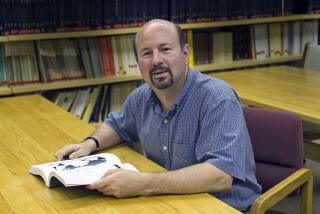MacArthur ‘genius’ grant winner creates artificial leaves that photosynthesize
It took nature millions of years to figure out how to turn energy from the sun into chemical energy that can be stored for a cloudy day - a process known as photosynthesis.
It took Peidong Yang, a chemist at UC Berkeley, about 10 years to accomplish a similar feat with the help of semiconductor nanowires and bacteria.
That’s one of the reasons he was awarded a “genius” fellowship from the MacArthur Foundation on Monday.
Yang said he heard the news about 10 days ago, when a representative from the foundation called him on his cellphone.
“It was just after my lunch, a total surprise,” he said. “It is such a huge honor to get this fellowship, and it is great recognition for the research we have been doing.”
Yang and his collaborators have created a synthetic leaf that uses the same ingredients as photosynthesis - water, sunlight and carbon dioxide - to produce liquid fuels like methane, butane and acetate. And just like nature’s version of photosynthesis, it releases oxygen into the air.
The technology is still several years from being commercially viable, but it represents an important step on the road to creating a truly carbon-neutral and sustainable fuel system.
“The feasibility of artificial photosynthesis has been demonstrated based on our earlier experiments,” Yang said. “We just need to keep pushing this research frontier.”
Yang, 44, is an inorganic chemist by training. He got his bachelor’s degree from the University of Science and Technology in China and his Ph.D. from Harvard University. He was a postdoctoral fellow at UC Santa Barbara before joining the faculty at UC Berkeley.
His interest in artificial photosynthesis came out of earlier work he did at Harvard with semiconductor nanowires. These microscopic wires - 100 to 1,000 times thinner than a human hair - have a variety of interesting properties, including that they are extremely good at capturing solar energy, Yang said. That’s a very helpful starting point for synthetic photosynthesis.
However, capturing solar energy is just the first half of the photosynthesis equation. To truly mimic what plant cells do, you need to store the sun’s energy so that it can be used later.
To do that, Yang and his team have experimented with a variety of different materials that can serve as catalysts - meaning they can facilitate a chemical reaction without being used up themselves.
Right now, the most effective catalyst the group has found is a species of bacteria called Sporomusa ovata, which takes electrons from the nanowires and uses them to turn carbon dioxide into the more complex molecule acetate. The current system uses a second bacterium, Escherichia coli, to turn the acetate into even more complex chemicals.
NEWSLETTER: Get the day’s top headlines from Times Editor Davan Maharaj >>
The hybrid synthetic and biological system works, but not quite as well as Yang would like. For example, he wants to find a synthetic catalyst that can do the required chemistry, rather than relying on bacteria.
“Bacteria live and die,” he said. “That’s a problem.”
He also said that for the artificial photosynthesis system to be commercially viable, it would need to be much more efficient than it is in the current model. It will also have to be more efficient than the one nature spent millions of years developing.
“We want to learn from nature, but we have to be better than nature,” he said.
The good news is that Yang thinks it’s possible.
“In solar panels the energy conversion efficiency is above 20%, much higher than what is happening in leaves,” he said. “So in terms of design, we have the advantage - nature doesn’t have silicon to use. We do.”
Science rules! Follow me @DeborahNetburn and “like” Los Angeles Times Science & Health on Facebook.
ALSO
NASA: Mars has salty flowing water today; could Red Planet host life?
Old-school and current vaccines have no link to autism (again), study says
Farm worker pesticide rules tightened







